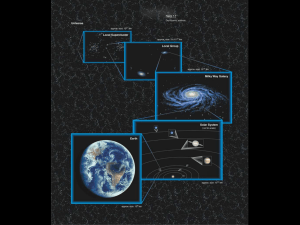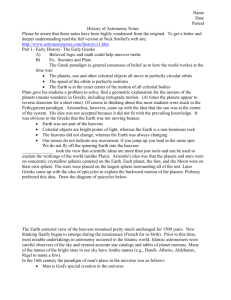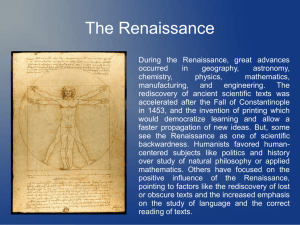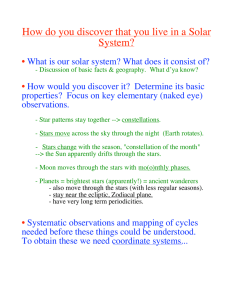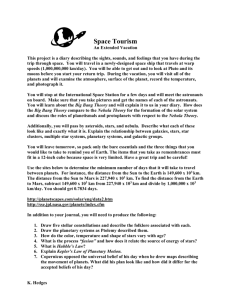AST 101 Lecture 6 Return to Heliocentrism
advertisement
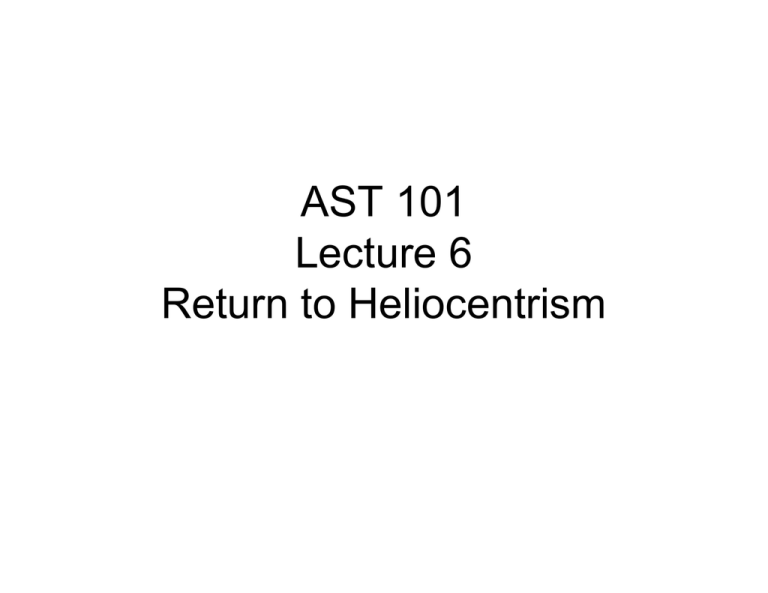
AST 101 Lecture 6 Return to Heliocentrism What needs explaining •Phases of the moon •Diurnal motion of the Sun •Annual motions of the stars •Inferior planets always near the Sun •Superior planets seen at all elongations •All planets exhibit retrograde motions Greek Cosmology •Geometry is the foundation of the universe •Perfection requires spheres and circular motions •Harmony of the spheres: ratios of small numbers •Epicycles preserve circular motions •Eudoxos required 27 spheres (5 per planet) •Aristotle: 55 interconnected crystalline spheres •Ptolemy: predicted planetary positions accurate for 1500 years The Ptolemaic Universe Greek science: some empiricism but philosophy wins in the end Islamic Astronomy Driven by practical needs: timekeeping and navigation •Lunar/solar calendar •Need to predict visibility of crescent moon •Need to know when to pray, and direction of Mecca Islamic scientists/mathematiciams invented spherical trigonometry Abu Ali Ibn Al-Haitham and the rise of empiricism • Abu Ali Ibn Al-Haitham (AlHazen); c. 965-1040 • Studied optics • First correct explanation of vision • Had doubts about Ptolemaic epicycles Epicycles • Planet fixed on epicycle • Epicycle revolves on deferent • Deferent centered on point between Earth and the equant Not truly geocentric! • Problems if interpreted mechanically Ulug Beg (1393-1449) • Grandson of Tamerlane • Constructed observatory in Samarkand • 30m quadrant • Catalog of 992 stars Islamic Astronomy II. • • • • Despite advances, not truly innovative Few recorded observations Refined Ptolemaic epicyclic elements Nasir al-Din al-Tusi and Ibn al-Shatir constructed epicyclic models that did not require an equant Copernicus (1473-1543) •Heliocentric model •Retained circular motions •Required epicycles to match observations •Inferior as a predictor to Ptolemy’s model De Revolutionibus Orbium Coelestium (1543) Tycho Brahe (1546-1601) •Geocentric model, but the planets orbit the Sun •Retained circular motions •Required epicycles to match observations •Excluded mechanical crystalline spheres •Showed comets were not atmospheric phenomena •Described a supernova Tycho’s Motivation Failure to detect parallax required either •Earth was stationary, or •Stars were very far away How far? •Tycho could measure about 1 arcmin •Using parallax, the distance in AU = 1/, where is the parallax in arcsec. •If the Earth orbits the Sun, the stars are > 3000 AU •This was too far for Tycho. Johannes Kepler (1571-1630) • The first astrophysicist? • A mathematician hired by Tycho to solve the orbit of Mars • It took over 20 years • He realized that the orbits of the planets were ellipses, not circles • Also a mystic and an astrologer Kepler’s Laws I. The orbits of the planets are ellipses, with the Sun at one focus. II. The line between the Sun and a planet sweeps out equal areas in equal times III. There is a relation between the orbital period and the mean distance to the Sun, p2 = a3 Galileo Galilei (1564-1642) • The first experimental physicist? – Demonstrated conservation of momentum • The first to use a telescope to observe stars/planets • Observed: – – – – – – Spots on the Sun Surface features on the Moon Phases of Venus The satellites of Jupiter The rings of Saturn Faint stars in the Milky Way Galileo vs. the Pope • The Catholic Church was not anti-science • Most scientists (including Copernicus) were priests or monks • The Church accepted the Copernican, heliocentric cosmology • But Galileo insulted Pope Urban VIII in his book Dialogue Concerning the Two Chief World Systems by identifying Simplicio, using the words of the Pope, with the Aristotelian geocentric position. • The Church could accuse Galileo of heresy, and they did

